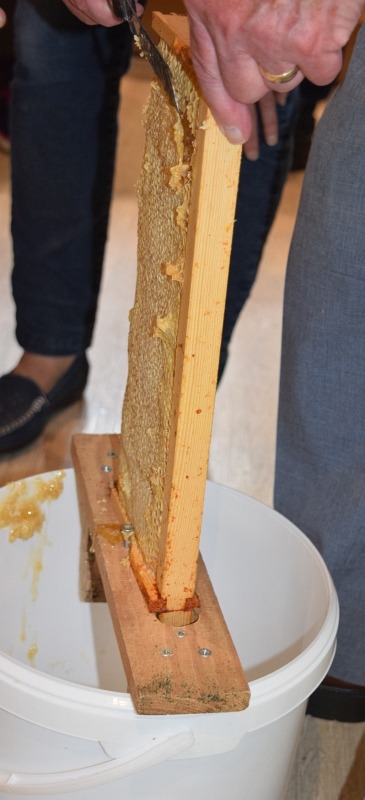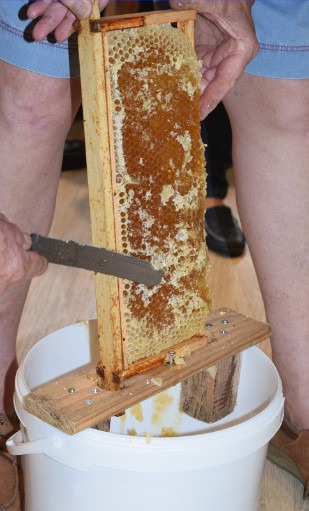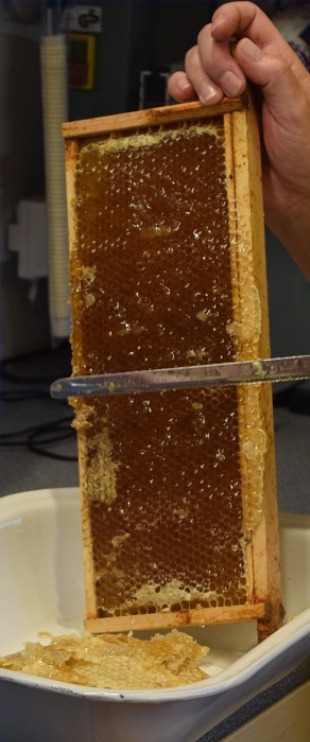It is that time of year when many of us are extracting honey - hopefully. In a couple of blogs I will cover some of the possibilities and techniques.
The first thing to do when getting the honey is to remove the full frames from the hive. Normally I put a board with a rhombus bee escape on the hive. I did this on one of my hives this year - but then life got in the way and I was not able to get back for a couple of days.
The result was the bees found their way back up to the honey and when we opened the hive we had bees right up to the crown board. Give them more than 24 hours separated from their stores and they will work out how to get to them. Clever little buggers these bees!
Now there are some who would tell you that you can clear a super with some smoke and a bee brush - well some you can but not this hive. These bees are not very friendly and even less so when I am trying to steal their stores.
One option, which I had never previously considered, was suggested at the recent bee meeting. Instead of taking a whole super just take a couple of frames from the middle of the super, shake off the bees and brush the rest off with a bee brush.Then put the frames out of reach of the bees. Push the remaining frames in the super together and put a replacement frame at each end of the super. This ways the bees are far less disturbed but it does mean that collecting ten frames takes five visits.
Anyway the title of the blog is decapping since that is what we were doing at the recent bee meeting.
One technique is to use a decapping knife. Below is my knife. The pen is there simply to indicate the scale.

My method for using this was to keep the knife in a tray of very hot water and when I came to use it I would support the frame vertically on end then slide the knife across the comb taking off the caps. A hot knife cuts through the wax caps more easily. You can get decapping knives which are electrically heated removing the need for the tray of hot water.
Using a decapping knife can be quite messy and results in a tray of wax cappings and honey. It can also miss a lot of the caps since bees do not build the frames with a view to making life easy for the honey thief. In addition there are some cells which are built larger than the others so the knife cuts off not just the cap but also a lot of the cell and its contents.

This picture shows the start of the decapping process using a knife. The frame is supported on a piece of wood resting across a bucket which will collect the drips of honey and the wax cappings.
Note that the wooden support can be made at home by screwing two blocks of wood on the cross beam so that the beam cannot fall into the bucket and then drill a suitable size hole for the end of the frame.
Or you could spend over £30 for a plastic holder that may not fit your bucket!
The angle of the knife is quite crucial as the aim is to remove all the cappings but none of the honey.

This shot shows the frame almost completely decapped. One advantage of using a decapping knife is that at the same time as you are taking off the caps you are also trimming the frame to fit the hive better. This is not the case with the hot air method of decapping described later.
Bare knees are not necessary but it is easier to wash honey of knees rather than trousers.

And this shot shows the frame almost completely decapped.
Note the cappings in the tray, These can be strained to get out some more honey and when you have got all you can then you can return the cappings to the hive and let the bees sort out the rest. The cappings are best returned to the hive from which they came to avoid cross contamination and upsetting the bees with smells from another hive.
In recent years I have used a completely different technique - hot air gun. The one I use is sold as a hot air gun by Screwfix. I hold the frame vertically as we do for knife decapping and then pass the hot air over the front of the frame. It takes just seconds for the caps to melt and draw back from the cell opening. I never let the gun stay over any area for too long as I only wish to melt the cap and not the cell or the honey.
In a recent session I was extracting a whole super and I only had two drops of wax that fell in the tray. The rest was left on the super ready for the bees to use again recapping full cells.
Anyway that is enough about decapping. Next time we will look at the extraction of the honey from the cells.
Stephen

